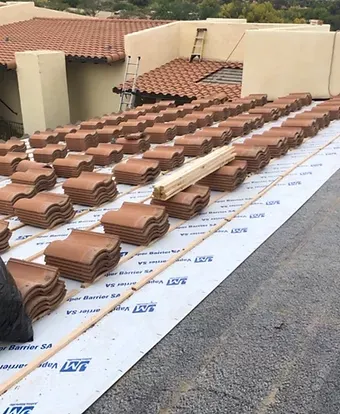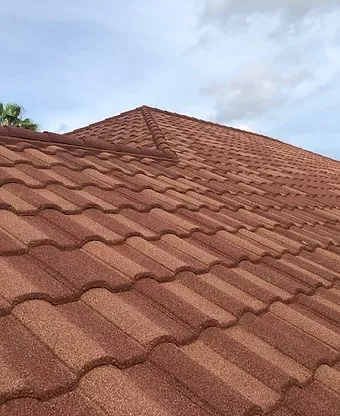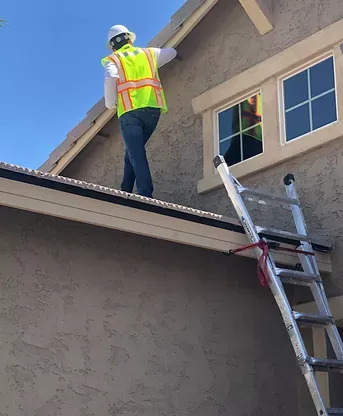A Homeowner's Guide to Flat Roof Materials and Maintenance in Southwest Florida
A Homeowner's Guide to Flat Roof Materials and Maintenance in Southwest Florida
Understanding Flat Roofs: Why They're Popular in Southwest Florida
Flat roofs have become a go-to choice for homeowners in Southwest Florida due to their practicality and adaptability to the region’s unique climate. These roofs are designed to handle high temperatures, intense UV exposure, and frequent rainstorms while offering energy-efficient benefits. Their low-profile design creates a sleek, modern look that complements contemporary architecture, making them an attractive option for those seeking both functionality and style. Additionally, flat roofs provide extra space for rooftop installations like solar panels or HVAC units, which can further enhance home efficiency.
Beyond their aesthetic appeal, flat roofs are gaining traction because they’re highly customizable and cost-effective. They work well with various roofing materials, allowing homeowners to tailor their choices based on budget and performance needs. The ability to incorporate features such as green roofs or cool roof coatings also makes them an environmentally friendly option. As more people recognize these advantages, the popularity of flat roofs continues to grow, especially in areas where durability and innovation are key priorities.
Types of Flat Roof Materials Used in Southwest Florida
In Southwest Florida, several flat roof materials stand out due to their performance in the local climate. TPO (Thermoplastic Olefin) is favored for its heat-reflective properties and affordability. PVC (Polyvinyl Chloride) offers excellent chemical resistance and durability, while EPDM (Ethylene Propylene Diene Monomer) rubber is known for its flexibility and ease of installation. Modified Bitumen provides a strong, waterproof layer ideal for smaller roofs, and Built-Up Roofing (BUR) is valued for its layered protection. Lastly, SPF (Spray Polyurethane Foam) delivers superior insulation and seamless coverage, though it requires regular recoating.
Each material comes with its own set of pros and cons. TPO and PVC are highly resistant to UV rays and heat , making them perfect for Florida’s sunny environment, but they may require professional repairs if damaged. EPDM is durable and long-lasting but less effective at reflecting sunlight. Modified Bitumen and BUR offer robust waterproofing but can be heavier and more labor-intensive to install. SPF excels in insulation but demands consistent maintenance to maintain its protective coating. Homeowners must weigh these factors carefully before deciding.
Given Southwest Florida’s scorching summers, heavy rainfall, and occasional hurricanes, certain materials tend to perform better than others. TPO and PVC are particularly well-suited for their reflective surfaces, which reduce cooling costs. Modified Bitumen holds up against storm damage, and SPF offers unmatched insulation benefits. By selecting materials tailored to withstand the region’s extreme weather patterns, homeowners can ensure their roofs remain reliable and efficient over time.
Key Considerations When Choosing a Flat Roof System
When selecting a flat roof system, homeowners should consider multiple factors to find the best fit for their property. Budget plays a significant role, as some materials like TPO and EPDM are more affordable upfront, while others like SPF may have higher initial costs but save money in the long run through energy efficiency. Property size and layout also matter; larger roofs might benefit from lightweight options like TPO, whereas smaller structures could accommodate heavier systems like BUR. Aesthetic preferences shouldn’t be overlooked either, as some materials blend seamlessly with modern designs.
Durability, R-value (insulation), and waterproofing capabilities are equally critical considerations. Homeowners need a roof that can endure years of sun exposure, torrential rains, and potential storm damage. Ease of repair and maintenance should also factor into the decision, as some systems are simpler to fix than others. For instance, TPO allows for straightforward patching, while SPF requires specialized recoating. Balancing these elements ensures the chosen system meets both immediate needs and long-term goals.
The Flat Roof Installation Process: What to Expect
Installing a flat roof involves several steps, starting with a thorough inspection of the existing structure to identify any underlying issues. Once the site is assessed, contractors will create a detailed plan outlining material requirements, timelines, and safety protocols. Materials are then delivered to the location, and the construction phase begins, which typically includes preparing the surface, applying underlayment, installing the chosen roofing material, and sealing edges and seams. This process requires precision to ensure proper water drainage and prevent future problems.
Several factors can influence project timelines and logistics. Access to the roof area is crucial, especially for larger properties where equipment and materials need to be transported efficiently. Weather conditions also play a significant role; rain or high winds can delay installation and compromise material integrity. Working with experienced professionals who understand Southwest Florida’s unique challenges ensures the job is completed smoothly and on schedule, minimizing disruptions to daily life.
Common Flat Roof Problems in Southwest Florida
Flat roofs in Southwest Florida face specific challenges, including ponding water, membrane cracks, leaks, blistering, and flashing or sealant failure. Heat and UV damage are common culprits, causing materials to degrade faster than expected. Wind and storm damage pose additional risks , often leading to punctures or tears in the roofing membrane. These issues can escalate quickly if not addressed promptly, resulting in costly repairs or even structural damage.
The region’s climate exacerbates many of these problems. Intense sunshine weakens materials over time, while heavy rains increase the likelihood of standing water, which can lead to leaks and rot. Hurricane-force winds test the resilience of every component, from membranes to fasteners. Understanding these vulnerabilities helps homeowners take proactive measures, such as scheduling regular inspections and investing in high-quality materials designed to withstand Florida’s demanding weather.
Flat Roof Maintenance: Essential Tasks and Schedules
Maintaining a flat roof involves routine tasks that keep it functioning optimally. Regularly cleaning debris like leaves and branches prevents clogs in drains and gutters, ensuring proper water flow. Checking for standing water after rainstorms is vital, as ponding can indicate drainage issues that need immediate attention. Inspecting seams, flashing, and sealants for signs of wear or damage helps catch small problems before they escalate. Homeowners should also verify that all rooftop equipment, such as vents and HVAC units, remains securely attached.
Scheduling professional inspections at least once a year is highly recommended, along with additional checks following major storms. During these evaluations, experts assess the roof’s overall condition, identify potential weaknesses, and recommend necessary repairs or upgrades. Homeowners can supplement professional visits with periodic DIY inspections, focusing on visible areas and reporting anything unusual to their contractor. Staying vigilant about maintenance reduces the risk of unexpected failures and extends the roof’s lifespan significantly.
Regular maintenance is one of the most effective ways to protect your investment. By addressing minor issues early, you avoid costly repairs down the line and ensure your roof performs reliably for years. Neglecting upkeep, on the other hand, can lead to premature aging and reduced durability, especially in Southwest Florida’s harsh environment. Prioritizing care and consistency pays off in the form of peace of mind and financial savings.
Repair vs. Replacement: Making the Right Call
Not all flat roof issues require a full replacement; sometimes, simple repairs suffice. Patching small leaks, replacing damaged sections of the membrane, or resealing flashing can restore functionality without breaking the bank. These fixes are ideal when the problem is isolated and doesn’t affect the entire system. Professional contractors can quickly diagnose the issue and determine whether a repair will suffice, saving homeowners time and money.
However, there are situations where replacement becomes inevitable. Widespread membrane deterioration, persistent leaks despite repeated repairs, or severe storm damage may signal the need for a new roof. Age is another critical factor—most flat roof systems last between 15 and 30 years, depending on the material and maintenance history. If the roof is nearing the end of its lifespan or repairs become too frequent and expensive, investing in a replacement ensures long-term reliability and better performance.
Energy Efficiency and Insulation for Flat Roofs
Flat roofs offer unique opportunities to boost a home’s energy efficiency , particularly in Southwest Florida’s hot climate. Materials like SPF and reflective coatings help deflect sunlight, reducing the amount of heat absorbed by the building. This translates to lower cooling costs during the sweltering summer months, making these options highly attractive for eco-conscious homeowners. Additionally, proper insulation minimizes temperature fluctuations inside the house, enhancing comfort and cutting utility bills.
Insulation options vary depending on the roofing material. For example, SPF provides built-in thermal resistance, while TPO and PVC rely on external layers for added R-value. Choosing the right combination of materials and insulation techniques ensures maximum efficiency and sustainability. Homeowners should consult with roofing professionals to explore solutions tailored to their specific needs, balancing upfront costs with long-term savings and environmental impact.
Hiring a Flat Roof Contractor in Southwest Florida: What to Know
Finding the right contractor is essential for a successful flat roof project. Start by verifying credentials, including licensing, insurance, and bonding, to ensure the company operates legally and protects against liability. Experience matters, so look for contractors who specialize in flat roof systems and have a proven track record in Southwest Florida. Reading reviews and asking for references can provide valuable insights into their reputation and quality of work.
Before hiring, ask important questions: What warranties do they offer? How do they handle unexpected issues during installation? Are they familiar with local codes and permits? Clear communication and transparency are key indicators of a trustworthy contractor. Additionally, inquire about post-installation support and maintenance services. Partnering with skilled professionals not only guarantees a durable result but also gives homeowners confidence in their investment.
Cost Factors and Budgeting for Flat Roof Work
The cost of flat roof work depends on several variables, including material choice, labor rates, roof size, and complexity. Premium options like SPF and PVC generally come with higher price tags but deliver greater longevity and energy savings. Labor costs fluctuate based on the scope of the project and the contractor’s expertise. Larger roofs or those with intricate designs may require more time and resources, impacting the overall budget.
To plan effectively, homeowners should allocate funds for both short-term and long-term expenses. Regular maintenance and minor repairs extend the roof’s life and prevent costly emergencies. When considering replacement, evaluate the return on investment by comparing upfront costs with potential savings on energy bills and reduced repair frequency. Consulting with multiple contractors and obtaining detailed quotes helps ensure accurate budgeting and informed decision-making.
Flat Roof Inspections: When and Why They Matter
Regular inspections are vital for maintaining a healthy flat roof, especially in Southwest Florida’s challenging climate. Experts recommend annual checkups, supplemented by additional assessments after major storms or hurricanes. During inspections, professionals examine the roof for signs of wear, damage, or blockages, identifying issues early enough to prevent escalation. Addressing minor concerns proactively saves homeowners from costly repairs and ensures their roof remains in top condition year-round.
Local Codes, Permits, and Warranty Considerations
Southwest Florida has specific building codes and permit requirements for flat roof projects, ensuring compliance with safety and environmental standards. Homeowners must secure the appropriate permits before beginning installation or replacement work, as failing to do so can result in fines or delays. Local authorities provide guidelines on acceptable materials and construction practices, which vary depending on the municipality. Understanding these regulations helps avoid complications and ensures a smooth process.
Warranties are another important consideration, offering protection for both materials and workmanship. Material warranties typically cover manufacturing defects, while labor warranties focus on installation quality. Homeowners should review terms carefully, noting coverage limits, exclusions, and claim procedures. Knowing what’s included—and what isn’t—empowers homeowners to make informed decisions and safeguard their investments for years to come.
Frequently Asked Questions (FAQ)
What types of flat roof materials are most commonly used in Southwest Florida?
TPO, PVC, Modified Bitumen, and SPF are among the most popular flat roof materials in Southwest Florida. Their widespread use stems from their ability to withstand the region’s heat, humidity, and storms. TPO and PVC excel in reflectivity, helping reduce cooling costs, while Modified Bitumen offers robust waterproofing. SPF stands out for its insulating properties, making it a favorite for energy-conscious homeowners.
How often should a flat roof be inspected?
Flat roofs should be inspected at least once a year, ideally before the rainy season begins. Additional inspections are recommended after hurricanes or significant weather events. These checkups allow professionals to spot early warning signs of damage, ensuring timely repairs and extending the roof’s lifespan.
What are the signs that my flat roof needs repair?
Warning signs include leaks, ponding water, visible cracks or blisters, and damaged flashing. Sagging areas or missing granules on the roof surface also indicate potential problems. Addressing these issues promptly prevents further damage and maintains the roof’s integrity.
How long do flat roof materials typically last?
Lifespans vary by material: TPO roofs last 15-20 years, PVC systems endure 20-30 years, and Modified Bitumen lasts around 15-20 years. SPF roofs can reach up to 30 years with proper recoating. Regular maintenance significantly impacts longevity, regardless of the material chosen.
Does insurance cover flat roof repairs or replacement in Southwest Florida?
Homeowner’s insurance often covers flat roof damage caused by storms, hail, or wind. However, routine wear and tear or neglect are usually excluded. It’s important to review policy details and consult with your provider to understand coverage specifics and limitations.
Conclusion
Choosing the right flat roof material and committing to regular maintenance are essential steps for protecting your home in Southwest Florida. With the region’s extreme weather and climate challenges, proactive care ensures your roof remains durable and efficient. By staying on top of inspections and addressing issues early, you can avoid expensive repairs and maximize the lifespan of your investment.
If you’re unsure where to start, don’t hesitate to reach out to experienced local roofing professionals. They can provide personalized advice, recommend suitable materials, and deliver quality installation services. Take the next step today: schedule a roof inspection, revisit your maintenance plan, or consult an expert to safeguard your home and enjoy peace of mind for years to come.




